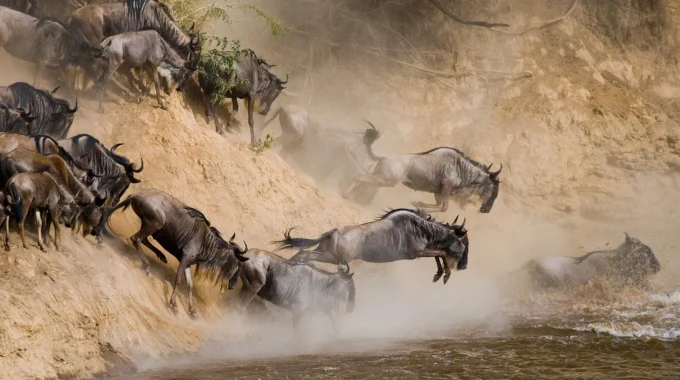A Kenya safari cost can vary significantly based on several factors, such as the season,…
What triggers wildebeest migration?
What triggers wildebeest migration? –
The wildebeest migration in Kenya and Tanzania is one of the most spectacular wildlife events in the world, driven by a variety of factors that are intricately tied to the animals’ survival strategies. Here are the key triggers and factors behind the migration:

1. Rainfall Patterns (Seasonal Rainfall)
- Primary Trigger: The wildebeest migration is primarily driven by the search for food and water, which are closely linked to rainfall patterns in the region. The animals migrate in search of fresh grass and water, which are abundant after the rains.
- Rainy Season Cycles: The migration is timed with the seasonal rains that occur in East Africa. The wildebeest follow the rains across the plains of the Serengeti (Tanzania) and Masai Mara (Kenya). Two wet seasons have a significant impact on their movement.
- Short rains (November to December): These rains encourage the wildebeest to move toward the southern Serengeti in Tanzania for calving.
- Long rains (March to May): These rains prompt the migration northward toward the Masai Mara in Kenya, where there is plenty of fresh vegetation.
- Annual Rainfall and Grass Growth: Wildebeests rely on the fresh, nutritious grasses that grow after the rains. Wildebeest migrate to new areas where new grass has started to grow during the dry season when rainfall in one area eats the grasses.
2. Calving Period (Late January to February)
- The timing of the migration is also closely linked to calving. Between January and February, the wildebeest return to the southern Serengeti plains in Tanzania, where the conditions are perfect for giving birth. The abundant grass and relatively safe environment from predators create an ideal place for the young wildebeest to be born.
- Mass Calving: This period sees the birth of around 500,000 wildebeest calves within a short window of time. By synchronizing calving, the sheer number of vulnerable calves overwhelms predators, increasing the chances of survival for the young.
3. Predator Pressure
- As the wildebeest move through different ecosystems, predator pressure plays a role in their behavior. Lions, cheetahs, hyenas, and other predators follow the wildebeest herds closely, preying on the weak, young, and sick animals.
- The movement to the Serengeti and then to the Masai Mara provides some level of predator evasion, but it also forces the wildebeest to constantly stay on the move, thus maintaining a dynamic migration pattern.
4. Grass Availability (Food Supply)
- Wildebeests are primarily grazers, and their migration is closely linked to the availability of fresh grass. They follow the rains, which trigger the growth of nutritious grasses.
- Nutrient Density: The wildebeest prefer young, nutritious grasses, which are vital for their survival and for the health of the calves. Since grass quality gradually declines, particularly following the dry season, migration is a crucial survival tactic.
5. Water Availability
- Along with food, water is a critical factor in the wildebeest migration. To guarantee that the herds have access to watering holes during the dry months, the migration route is designed accordingly.
- The wildebeest usually migrate from one water source to another, traversing rivers such as the Mara River in Kenya. This is a dangerous and spectacular aspect of the journey, as they have to deal with crocodiles and powerful currents.
6. Predator-Prey Dynamics
- Additionally, the dynamics of predator-prey relationships impact wildebeest movement. Predators, particularly lions, often follow wildebeest herds, and the herds instinctively move to safer areas or change direction to avoid becoming prey. However, large numbers of wildebeest also support the survival of many young calves, as predators struggle to catch them all.
7. Social Structure and Herd Instincts
- Wildebeests are social animals, and migration is a collective phenomenon influenced by group dynamics. The herds move together in massive groups, following the leader and the collective instinct to migrate at the right time.
- Herd Behavior: The wildebeest follow a strong social structure, with older and more experienced individuals leading the group. Their strong herd instincts make the migration a cooperative activity that maximizes the chances of survival for the entire herd.
8. Temperature and Climate Changes
- Wildebeest migration is influenced by the climate of East Africa. Temperature changes, especially the onset of the rainy season, create more favorable conditions for growth and sustenance. Warmer temperatures after the rainy season encourage the growth of grass, which in turn draws the wildebeest into areas where they can feed.
The Migration in Kenya and Tanzania
- Serengeti (Tanzania): The southern Serengeti, particularly the short grass plains, becomes a crucial calving ground from January to March. Newborn safety and the abundance of grass are well-known features of the area.
- Masai Mara (Kenya): By late July through October, the herds move northward toward the Masai Mara, crossing the Mara River. This crossing is one of the most dramatic aspects of the migration, as large groups of wildebeest attempt to navigate the river, risking crocodile attacks.
The migration continues to be a result of an interplay of ecological factors, with the wildebeest’s survival tied to the environment’s seasonal cycles. The migration between Tanzania and Kenya is not only a quest for food and water, but it also demonstrates how remarkably adaptive wildebeest are to shifting environmental conditions.
Contact us here at Adventure in the Wild Safaris to help you organize your East African tour to see the wildebeest migration.



